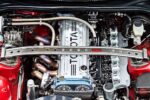Chevy I5 Engine: A Brief Overview
History and Development
The Chevy I5 engine, also known as the 2.5L inline-5 engine, has been a notable part of General Motors’ engine lineup since its introduction in the early 2000s. Designed primarily for compact and mid-size vehicles, this engine was engineered to provide a balance of performance and fuel efficiency. The I5 engine was first utilized in models such as the Chevrolet Colorado and GMC Canyon, aiming to fill the gap between the traditional four-cylinder and six-cylinder engines.
With a unique five-cylinder configuration, the I5 engine offered a distinctive sound and a smoother operation compared to its four-cylinder counterparts. This engine was particularly appealing to consumers looking for a vehicle that could deliver adequate power without sacrificing fuel economy. Over the years, the I5 engine has undergone various updates and modifications, including improvements in fuel injection systems and emissions control technologies, to meet evolving environmental standards and consumer expectations.
However, despite its initial promise, the Chevy I5 engine has not been without its share of issues. As with any engine, the I5 has faced a range of problems that have raised concerns among owners and mechanics alike. Understanding these issues is crucial for current and prospective owners, as they can significantly impact the vehicle’s reliability and performance. This article will delve into the common problems associated with the Chevy I5 engine, providing a straightforward examination of its shortcomings and what owners should be aware of.
Common Problems with the Chevy I5 Engine
The Chevy I5 engine, while innovative for its time, has been plagued by several issues that have affected its performance and reliability. Owners of vehicles equipped with this engine have reported a variety of problems, ranging from minor inconveniences to serious mechanical failures. Understanding these issues is essential for anyone considering purchasing a vehicle with the I5 engine or for current owners looking to maintain their investment.
1. Engine Misfires
One of the most frequently reported problems with the Chevy I5 engine is engine misfires. Misfires can occur for several reasons, including:
- Faulty spark plugs
- Defective ignition coils
- Fuel delivery issues
When misfires happen, drivers may experience a rough idle, decreased power, and increased fuel consumption. Ignoring these symptoms can lead to more severe engine damage over time.
2. Oil Consumption Issues
Another significant concern is excessive oil consumption. Many owners have reported that their I5 engines consume oil at an alarming rate. This can be attributed to:
- Piston ring wear
- Valve seal deterioration
- Oil leaks
If not addressed, excessive oil consumption can lead to engine wear and potential failure, making regular oil checks and changes crucial.
3. Timing Chain Problems
The timing chain in the Chevy I5 engine is another area where issues can arise. Problems with the timing chain can cause:
- Engine noise
- Rough running conditions
- Complete engine failure if the chain breaks
Regular maintenance and timely replacement of the timing chain are essential to prevent catastrophic engine damage.
4. Fuel Injector Failures
Fuel injectors are critical for maintaining the engine’s performance and efficiency. However, I5 engine owners have reported issues with fuel injector failures, which can lead to:
- Decreased fuel efficiency
- Engine stalling
- Increased emissions
Replacing faulty fuel injectors promptly can help maintain engine performance and prevent further complications.
5. Overheating
Overheating is a serious issue that can cause extensive damage to the engine. Common causes of overheating in the Chevy I5 engine include:
- Coolant leaks
- Faulty water pump
- Thermostat failure
If the engine overheats, it can lead to warped cylinder heads or a blown head gasket, both of which are costly repairs.
Symptoms and Consequences
Understanding the symptoms associated with these problems can help owners take preventive measures. The following table summarizes common symptoms and their potential consequences:
| Symptom | Potential Consequence |
|---|---|
| Engine misfire | Decreased power and efficiency |
| Excessive oil consumption | Increased wear and potential engine failure |
| Timing chain noise | Risk of engine failure |
| Fuel injector issues | Stalling and increased emissions |
| Overheating | Warped heads or blown head gasket |
Or open the survey in a new tab: Take the Survey




0 Comments